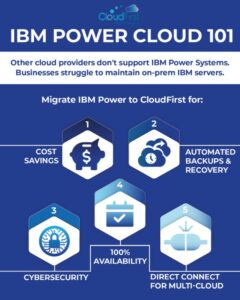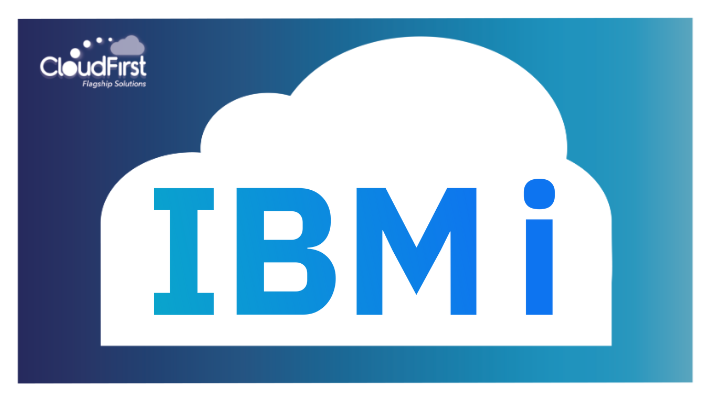After investing time and money into your IBM Power Systems for years, it’s frustrating to realize that most major cloud platforms aren’t compatible with IBM i series or AIX. It doesn’t just feel like IBM is being left behind—it feels like you are. It’s even more puzzling when you learn that thousands of companies still use IBM Power around the world, with 60% of them being based in the United States.
As cloud hosting becomes more commonplace, so too does the desire to find ways to connect and transmit your data without gutting your current infrastructure. But if your company relies on Power Systems, you probably feel stuck between a rock and a hard place. Cloud providers like AWS and Azure don’t support the infrastructure you need to run mission-critical databases and applications.
So how do you proceed? On the one hand, sticking with the status quo and continuing to maintain on-premises IBM Power i or IBM AIX systems is difficult and costly when the rest of your IT has moved to the cloud. On the other hand, starting from scratch on a new platform is a remarkably expensive and time-consuming endeavor.
There’s another way, one that doesn’t involve a lose-lose situation for the business owner who wants to keep things as they are: deploying IBM Power Systems in a dedicated cloud environment. This cloud hosting solution relieves the burden of managing and maintaining your own servers, enabling you to move your IBM systems seamlessly to the cloud.
But how does it work? Why is this possible with CloudFirst when other big names in the industry, like Microsoft Azure and AWS, don’t support IBM Power in their public clouds?
What is an IBM Power Systems cloud environment?

The IBM Power Systems cloud environment is an IBM-friendly cloud hosting solution designed to transform how you host and use your data. It enables companies that operate with Power to access all the benefits of the cloud they wouldn’t be able to otherwise—things like enhanced privacy, scalability, availability, and IT cost savings.
This cloud hosting solution works thanks to IBM Cloud Direct Connect. This private, completely secure connection offers low-latency, high-speed pathways to directly integrate IBM Power with other cloud hosts. The process is so fast and seamless that it essentially operates as one network; there are no tolls or speed bumps along the way preventing you from getting the best possible network experience.
When you migrate your IBM i or IBM AIX servers and workloads to the cloud, you no longer have to maintain the hardware, the software, or the networking between them and the rest of your IT on other cloud platforms.
By choosing a cloud provider that specializes in IBM Power Systems, you get the advantage of dedicated specialists, 24-7 security and support, and expert guidance in securing your IBM Power System when migrating to the cloud. You also get a solution that pleases the CFO just as much as it does the head of IT.
Why won’t other cloud providers support IBM Power?

It’s a common scenario: an organization starts a cloud initiative, moves their IT to a public cloud, and then finds out that the hyperscalers don’t support IBM Power. What justification do the big cloud companies have for ignoring the needs of those who want to continue using their tried-and-true IBM systems?
The answer is that companies like Amazon and Microsoft consider IBM Power too niche a market for them to tap into. They’ve all but given up on anyone who wants to keep their IBM infrastructures. In fact, many IT graduates aren’t even learning how to handle these systems, so not enough industry professionals have the specialized skill set required to administer Power servers in a data center.
Since the demand for it is smaller, the big companies see no point in allocating resources to make their operations compatible with Power. They think it’s easier to strongarm companies into upending how their IT works or finding alternative solutions.
But it’s not that simple, especially for companies that have been using IBM systems for decades and might even prefer to continue using them while taking advantage of everything the cloud offers. Andrew Hudson writes for Ars Technica that “two-thirds of Fortune 500 companies, 45 of the world’s top 50 banks, eight of the top 10 insurers, seven of the top 10 global retailers, and eight of the top 10 telecommunications companies” still use mainframes, many of which come from IBM.
Why move IBM Power to the cloud at all?
Companies need to modernize their IT, adapting older technology to work with newer technology. For instance, databases on IBM i operate well with modern-day Linux and Windows systems, but there’s still very little support for managing IBM i hosting on the cloud. This is a frustrating situation considering how many businesses continue to use IBM technology and that it would cost them a fortune to reconfigure.
Lots of companies have already moved most of their infrastructure to the cloud, with IBM Power being the last bastion of their IT team’s old guard. Since they can’t find a way to operate Power Systems on the cloud, companies consistently compromise on how they access their information and where they can keep it. And while there are important network considerations when migrating IBM Power Systems to the cloud, there are so many ways companies can benefit from an IBM Power hybrid cloud.
Guaranteed availability
One of the cloud’s most enticing benefits is how easy it is to access everything you need. Cloud management systems are fantastic for streamlining this access, and now with integrated support for IBM Power, it’s become significantly easier to manage every element of your IT in one place with guaranteed availability.
Scalability
Scalability means having the means and options available to grow while keeping the growing pains to a minimum. A Power hybrid cloud environment makes scalability a snap; there’s no more worrying about hitting the limits of data storage, compute, or other resources.
You can now seamlessly integrate IBM Power with other cloud hosting services and update your storage usage to grow your business without feeling constrained by limitations.
Cost savings
There’s a long list of ways that cloud computing saves companies money.
This includes:
- Reduced hardware costs
- Reduced maintenance costs, especially for scarce talent
- Lower electricity costs and carbon footprint
- Switching IT spending from CAPEX to OPEX
Security
Another reason companies move to the cloud is for improved cybersecurity. Forbes mentions how valuable something like an IBM Cloud environment is for a company’s cybersecurity needs. They go further than suggesting that companies only need to worry about attacks from bad actors as a part of their cybersecurity plan; they also give consideration to the cost of physical security that IBM Power Systems on the cloud alleviates.
And even if you can afford the astronomical expense involved in the upkeep of physical security, a cloud environment still protects your business from falling victim to natural disasters like flooding, fires, and earthquakes.
The baseline of IBM Power Systems cloud environments
You don’t have to leave your Power Systems behind; with CloudFirst solutions for IBM Power, there’s finally a way to modernize every aspect of your IT without starting from scratch. From there, we can combine our IBM cloud environment into a hybrid setup by integrating it with the rest of your IT stack no matter where it’s hosted.
Want to learn more about how to integrate IBM Power Systems with AWS or Azure on the cloud? Download our free whitepaper now to harness the full power of multi-cloud IT.

